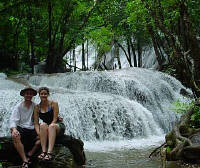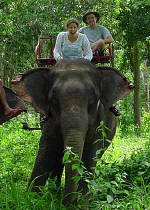Motos, Temples and Some Guy at the Airport
August 9th, 2002
Karl is his name. He’s the local consulate warden for the British Embassy in Siem Riep as well as owner and proprietor of the place we’re staying in town, The Ivy Guesthouse. Karl is a great guy and Sean is about to see some pretty cool sights other tourists miss out on, but right now Sean is clinging for dear life to the aluminum rack on the back of Karl’s dirtbike as they zoom past a large truck that is wobbling dangerously under a load of timber. A peek at the speedometer reveals they’ve just topped 95 MPH zooming down this little pothole-filled dirt road in Cambodia. Closing his eyes as much against the tear-enducing wind as for reassurance, Sean reflects that this is probably half as dangerous as his ride yesterday through town on another bike, speeding along in a fierce monsoon downpour.


Thailand waterfall
![]()
![]()
If this is how you picture South-East Asia, you’d probably be right in most cases. Motorcycles (called simply “motos” out here) are the main means of transportation, as paved roads, sidewalks, highways and traffic lights are all but unheard of in smaller towns. There is respite: such road conditions are slightly less common in big cities like Bangkok, Thailand. Bangkok prickles with sky-scrapers, bustles with suit-and-tie businessmen and yet still somehow allows the co-existence of bamboo-and-tin bungalows next to winding, muddied waterways that would look less out of place in a jungle. Soon after their arrival in Bangkok, Sean and Kim found themselves strolling onto the infamous Khao San Road with their framepacks, looking around at the 6 a.m. wreckage of a neighborhood that parties until sunrise. Checking into their hotel (called…no kidding… “Lucky Beer”), they decided to stroll around until the afternoon sun made strolling around an unbearable activity.
Much to their surprise (and Kim’s delight), Thailand never reached the heights of temperature our heroes had experienced in Greece. Sure, there’s humidity… but after their recent experience with dry, desert-like Mediterranean summer weather, it was a relief. After one of its frequent showers, the air in Bangkok can be quite invigorating. Khao San Road is a part of Banglamphu, the “backpackers ghetto” in Bangkok, and in recent years it has become more and more convenient and less of a “ghetto” as local Thais move into the neighborhood hoping to make more money there than they would elsewhere. According to locals, backpackers as a group actually put more money into the hands of private businesses than upscale tourists who give most of their money to chain hotels where everything is included in one tour package price. If you were to take San Francisco’s Chinatown, cross it with Telegraph Avenue, throw in an Oakland/Hayward flea market and move it to Thailand, you might have something very similar to Khao San Road.
Things to do on Khao San road:
Eat the best Pad Thai of your life: 50 cents from a street vendor.
Drink the strongest Mai Tai of your life: one dollar.
Buy an entirely new wardrobe, custom-fit and made from scratch: $200
Watch a large-screen DVD playback of a movie that has yet to be released (we saw Spiderman and Men In Black II, among others): Free in any bar or restaurant.
Splurge on a Hotel with AC, Swimming pool… the works: $10
Stay in a small room with a fan: $5
Drink a delicious fruit shake in the afternoon heat: 25 cents
Thai Massage: $3 for one hour.
Pedicure and foot massage: $2
Debate whether the Canadian tourist across the street knows that it’s a man he’s hitting on: Free.
Eat any variety of roasted and spiced insects: We didn’t ask, but it’s there.


Elephant riding
![]()
![]()
So enamored were we of the area, we spent about three days just strolling around, enjoying the incredible food, window-shopping, watching movies over dinner and talking to other world travellers. We booked a three-day private tour through the surrounding countryside that took us to museums and monuments affiliated with WWII (yes, we saw the bridge over the river Kwai and rode the “death railroad” where the Japanese forced thousands of Allied POWs to work themselves to death in its construction), allowed us to ride an elephant (definitely a highlight), stay in a mountain village in bamboo tree houses, see a few local waterfalls, spend an afternoon trekking through a jungle, go river rafting and dodge bats in an underground cave.
Of the three day trek, our favorite memory was on the river. We were with two other couples at that point (our group varied from just us to up to five other people, depending on where we were) on a bamboo raft when suddenly, with a tremendous crack of thunder, the skies split wide open and a torrential downpour began. Five minutes later, Cynthia from Canada stood up under the small thatched cover in the middle of the raft and said,
“Hey, I’m just as wet under this thing as if I was out there,” walked over to the edge of the raft and jumped in. Within a few minutes, we were all with her, bobbing along in our lifejackets like apples at a halloween party. Kim spun around slowly in the current, marveling at the white haze that stretched across the river, only visible from a head-just-above-water vantage point, the passing jungle scenery and the cloud-ringed mountains sometimes peeking through the storm before seizing her husband forcibly and relating to him through the downpour that this was absolutely the most romantic thing that had ever happened in her life. Just as we were all voicing our agreeable sentiments that being in the river was much warmer than standing than the rain, Dave from New York rescued a sizeable branch and a small round fruit from the water:
“Play balllll!” Laughing, hands behind our heads, feet in the air from the buoyancy of our jackets, we took a break from goofing off to note the incredible current of the river and debate whether we were heading for a waterfall.
“No way a river is going this fast without some kind of waterfall up ahead,” Dave commented. As it turned out, there was no waterfall (that we saw), but the Karaoke machine at the jungle bar that night more than made up for any excitement we might have missed. Hoo boy… if anyone ever offers you Thai whiskey or tequila… just say no. Especially if there’s a karaoke machine in the room. Thank goodness we were in the middle of the jungle and far from any outside witnesses.
Upon returning from our trek we gratefully checked into one of those swanky $10 rooms for a bit of pampering before departing for Cambodia. First stop: Siem Riep, a small village outpost close to Angkor Wat, where some of the world’s most spectacular temples, recently rescued from the jungle, await visitors (for those of you who noticed there was a movie attempting to happen behind Angelina Jolie in “Tomb Raider,” the jungle temple scenes were filmed in Angkor Wat).
At the temples, locals drape orange cloths around the shoulders of fragmented statues of Buddha, lighting incense, praying and leaving flowers at the feet of prominently placed sculptures. Cambodia’s temples are approximately 1,000 years old and have experienced a fascinating interplay between an originally dominant Hindu society and a later, but vigorous, Buddhist one. Many Hindu statues in the older temples have been altered to change a Vishnu (or a Ganesha, or a Shiva or… etc) into a Buddha, re-sanctifying the temple into the new dominant religion, whereas the majority of other shrines simply incorporate aspects of Hindu religion and mythology into its version of Buddhism, making for some fascinating and beautiful sculpture and ornamentation.
Mostly made of sandstone and all but overtaken by the jungle until the last half of this century, the temples are worn remnants of a culture that dominated much of SE Asia and hosted a period of Hindu worship some scholars feel is more dynamic and influential than that of India. And the temples! Huge, multi-storied behemoths of stone, faded wall etchings and huge faces, giant railings that upon closer observation are carved to resemble a poised serpent. Some temples are still all but overwhelmed by vegetation: ancient trees wrap tendril-like roots around entire structures, vines hang from openings and ferns grow peacefully from the spaces between the stones of a wall. Indiana Jones, eat your heart out!
Nights would find Kim trouncing Sean at a game of pool at the Ivy Bar while small groups of geckos lay against the wall beneath the light fixtures, darting a few inches every now and then for a snack. Across the dirt road (all the roads in Siem Riep are dirt) is the old market where fish mongers mingle with “antique” vendors, farmers sell fruits and vegetables and other small booths sell everything from fireworks to ring-pull-top soda cans. Motos and tuk-tuk drivers muscle each other for tourist dollars outside of every bar, and the occasional street person adjusts his amputated leg for better view of the passersby. Days would find your happy honeymooners beneath the canopy and bouncing tassles of “Mr. Ron’s” tuk-tuk, exploring temples and waving back at the astonishingly friendly local children who rush out to the roadside as we passed by.
On the morning of August 7th we cracked open our last coconut in Siem Riep and caught our last tuk-tuk to the airport where we discovered our flight had been delayed… for four hours. We weren’t feeling all that put out, after all, Sean had his guitar and Kim had her nose pressed to the glass, revelling in the monsoon rains that erupted mid-afternoon. Besides, waiting for his flight next to us, Guy Pearce seemed relatively content, so why shouldn’t we be, too?
Next we explore Phnom Penh, Cambodia’s capital city, before spending a week in Vietnam and then ten days making our way from Bangkok to Singapore.